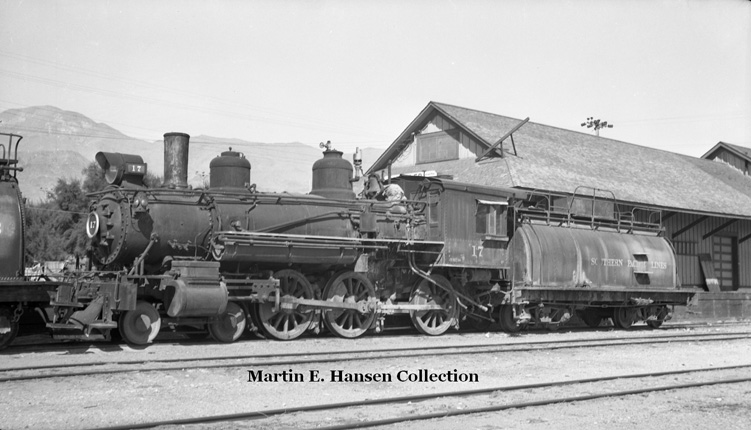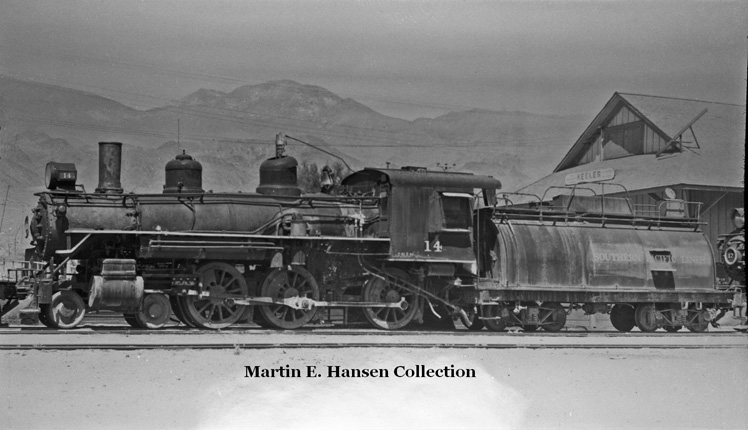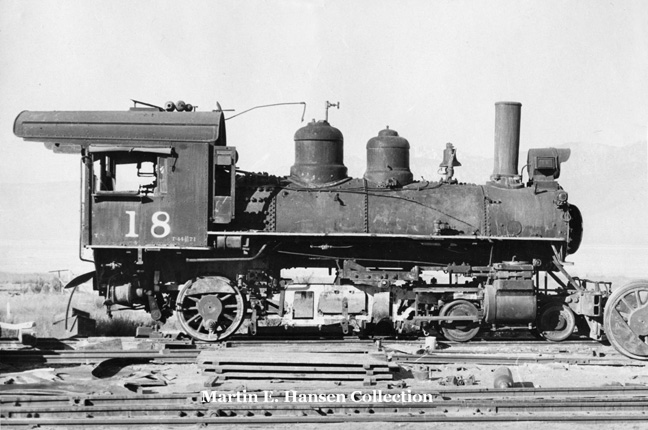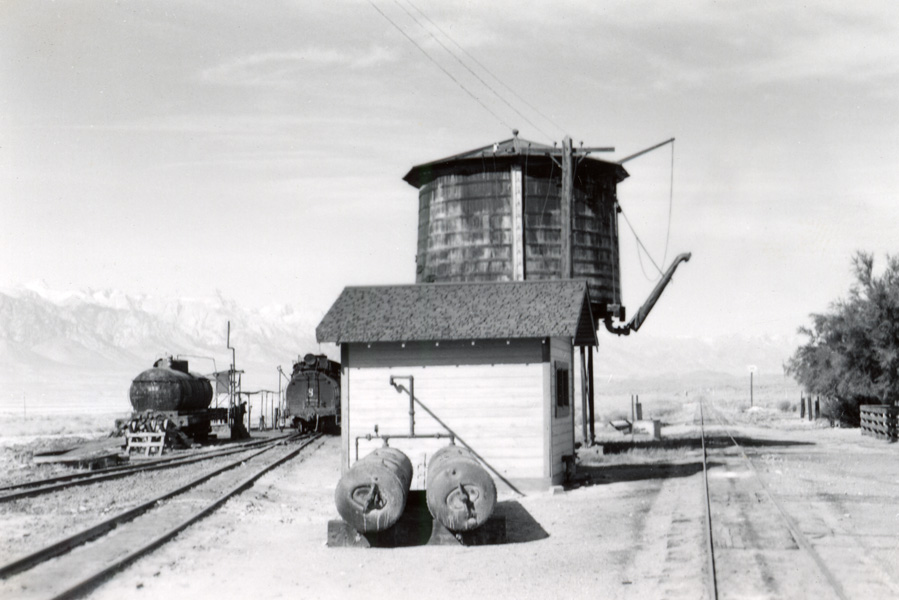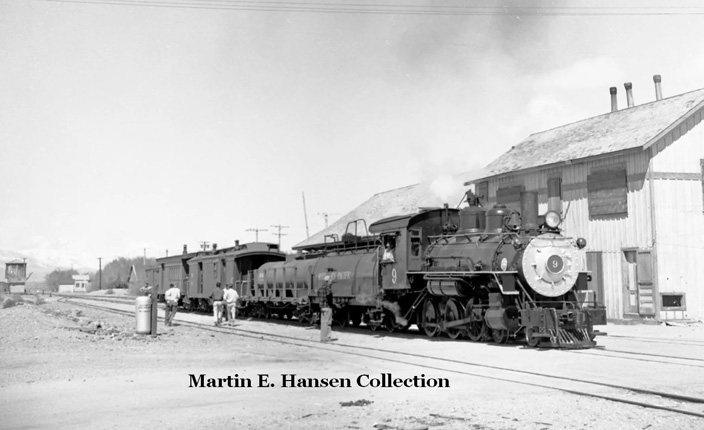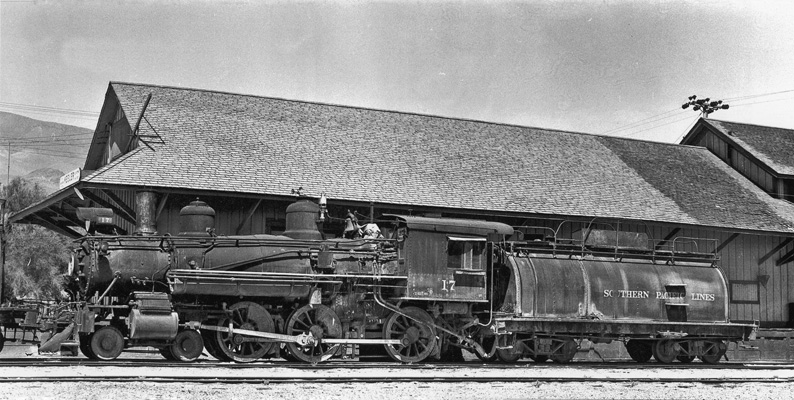|
|





































































































































































|
|
Southern Pacific Narrow Gauge Railroad |

|
Keeler
Cerro Gordo
Bowland
Owens Lake
|
|

All material courtesy of Rich McCutchan unless otherwise noted.
See USE NOTICE on Home Page.

|

 07/23 07/23
 SPNG (Baldwin narrow gauge 4-6-0, b/n 34035, built November 1909) is seen running between Owenyo and Keeler, CA on August 25, 1959
SPNG (Baldwin narrow gauge 4-6-0, b/n 34035, built November 1909) is seen running between Owenyo and Keeler, CA on August 25, 1959
(Photo post courtesy of Rob Sarberenyl - Photo and text by John West) |


Engine Nos.
9 and 18 on and evening run.
|
 Southern Pacific. Engine #8 at Keeler with the depot towering over the boxcars. 10-31-50
Southern Pacific. Engine #8 at Keeler with the depot towering over the boxcars. 10-31-50
(Photo courtesy of University of Nevada, Reno - Online Digital Collections)
|
 08/22
 Consider a standard gauge mainline railroad who also operates a lone steam powered narrow gauge operation in one of the most remote locations in the American West. One would easily believe that this kind of operation would need shop facilities of it's own that would be considerable enough in their own right to keep this remote steam fleet in service. Well, guess again.
Consider a standard gauge mainline railroad who also operates a lone steam powered narrow gauge operation in one of the most remote locations in the American West. One would easily believe that this kind of operation would need shop facilities of it's own that would be considerable enough in their own right to keep this remote steam fleet in service. Well, guess again.
By the late 1940's into 1960, what we see here in Keeler, California was the only shop facility that Southern Pacific had on it's remote Keeler Branch to keep the small fleet of narrow gauge steam locomotives in service. While Keeler never boasted what one would think would be required to be the lone on-site shop facility for the narrow gauge branch, it did at least have a single stall enginehouse until even that burned in 1946. After that, what we see here were considered the "shops" for the Keeler Branch for the rest of the time that branch operated.
When the steam locomtoives (and later even the lines lone diesel locomotive) needed heavy repairs the solution was to load that locomotive on a standard gauge flatcar at Owenyo, and send it out over SP's Jawbone Line to the SP shops in Bakersfield, California. However, the daily maintenance all took place in the rain, snow or sunshine outside at this spot in Keeler. The line lasted in operation until April, 1960, so this must have worked.
(Photo and text courtesy of Martin Hansen) |

 09/22 09/22

This is the last stop, for passengers at least of the Carson and Colorado Railroad, whose nickname was The Slim Princess. The name is derived from its tracks, narrow gauge (3ft. Wide). The town was named Hawley but was changed to Keeler it is located on the Eastern side of Owens Lake, in the Owens Valley, in Eastern California.
It started as one side of a ferry boat link that carried mostly silver from Cerro Gordo, located to the east in the steep Inyo Mountains. The ore first came down by wagon and later an aerial tramway. The steamship ferry, Bessie Bradie ran across Owens Lake to Cartago on the Western shore. Originally the Ferry left from Swansea just to the North of Keeler, after an Earthquake in 1872 there was a shift in the lake shore and it was moved south, there is more to that story, but that's for later.
The Railroad came to town in 1883, and the mines from up the hill were doing well they started to carry Cerro Gordo's silver, later Lead, Zinc, and some Gold and Copper also. Plus thriving chemical companies popped up to the south and along the Inyos at different spur locations. The railroad was bought by the Southern Pacific Railroad and it continued to run until 1960, the rails were pulled up in 1961.
(Photo and text courtesy of David Wayne Bailey)
|
 09/22
 Number 8 was photographed at Keeler - 1951
Number 8 was photographed at Keeler - 1951
(Photo courtesy of Dillon Trinh) |
 Keeler Soda Works along the Carson & Colorado RR
Keeler Soda Works along the Carson & Colorado RR |

No. 9 waits
for a switch at Keeler back in 1938.
|

"End of
the line."
|
 Stranded by
economics, geography and time, the Owens Valley narrow gauge
traversed a beautiful and remote land on the east side of the
Sierra Nevada Mountains. The former Florence & Cripple Creek
Engine No. 22 drifts into Keeler in 1940.
Stranded by
economics, geography and time, the Owens Valley narrow gauge
traversed a beautiful and remote land on the east side of the
Sierra Nevada Mountains. The former Florence & Cripple Creek
Engine No. 22 drifts into Keeler in 1940. |

Transferring bags of gypsum at Keeler.
|

Slim Princess No. 9 switches a string of cars at Keeler.
|

Engine No. 9 is turned on the Keeler wye as fans watch. |

Keeler Depot with Cerro Gordo Tramway Terminal in the distance - 1948 |
 Engine Nos.
9 and 18 on and evening run from Keeler.
Engine Nos.
9 and 18 on and evening run from Keeler.
This is Keeler looking kind of south/east towards the Inyo Mountains. Water tank in the background. The locomotives are sitting on the service track. Engine house would be a short distance in front of the locomotives. . |
 Cerro Gordo terminus, just south of Keeler on the SPNG in Owens Valley.
Cerro Gordo terminus, just south of Keeler on the SPNG in Owens Valley. |
 Digging out
the rails after a flash flood at Keeler in 1919.
Digging out
the rails after a flash flood at Keeler in 1919. |
 The Inyo Development
Company engine No. 1 at work at Keeler in 1904.
The Inyo Development
Company engine No. 1 at work at Keeler in 1904.
(Eastern
California Museum) |
 Engine No.
9 steaming home to Keeler with a five car consist in the late
afternoon of December 18, 1948.
Engine No.
9 steaming home to Keeler with a five car consist in the late
afternoon of December 18, 1948. |
 Engine No.
8 steaming out of Keeler with a short consist.
Engine No.
8 steaming out of Keeler with a short consist. |
 Engine No.
18 heading north out of Keeler with 14, 495' Mt. Whitney (far
right) towering in the distance.
Engine No.
18 heading north out of Keeler with 14, 495' Mt. Whitney (far
right) towering in the distance. |
 Engine facilities
at Keeler, California.
Engine facilities
at Keeler, California. |
 The Inyo
Development Company was formed in 1885 by D.O. Mills to recover
soda ash from Owens Lake. In 1902 the firm purchased a Eureka
& Palisade 2-6-0 from the Bodie & Benton, and had the
Mogul rebuilt by the Virginia & Truckee's Carson Shop. The
I.D.C. locomotive (above) is en route to Keeler 1902.
The Inyo
Development Company was formed in 1885 by D.O. Mills to recover
soda ash from Owens Lake. In 1902 the firm purchased a Eureka
& Palisade 2-6-0 from the Bodie & Benton, and had the
Mogul rebuilt by the Virginia & Truckee's Carson Shop. The
I.D.C. locomotive (above) is en route to Keeler 1902. |
 Cerro Gordo aerial tram terminus at Keeler. Built in 1908 by the Cerro Gordo
Mines Company, it connected the silver mine with the railroad.
Cerro Gordo aerial tram terminus at Keeler. Built in 1908 by the Cerro Gordo
Mines Company, it connected the silver mine with the railroad. |
 Here empty cars
await the turning of the tram cable wheels at the Keeler terminus.
The tramway was dismantled in 1960 and transported bolt and board
to Candelaria, Nevada to participate in a modern day mining promotion.
Here empty cars
await the turning of the tram cable wheels at the Keeler terminus.
The tramway was dismantled in 1960 and transported bolt and board
to Candelaria, Nevada to participate in a modern day mining promotion. |

Carson & Colorado RR at the Cerro Gordo plant in Keeler
(Photo courtesy of Dennis Burke) |

Here's a great Bill Poole photo of SPNG #9 at Keeler on the track where the Engine House once stood.
(Text and Photo courtesy of Dennis Burke) |
 Built in 1915,
the Cerro Gordo tramway was operated until 1927. For the next
33 years, the ore buckets (some still full) quietly hung as silent
sentinels reminiscent of the bonanza passed.
Built in 1915,
the Cerro Gordo tramway was operated until 1927. For the next
33 years, the ore buckets (some still full) quietly hung as silent
sentinels reminiscent of the bonanza passed. |
 A portion of
the $213,392,000 in silver bullion produced by the Cerro Gordo
mine between 1880 and 1948 stacked up on the shores of Owens
Lake awaiting shipment to Los Angeles.
A portion of
the $213,392,000 in silver bullion produced by the Cerro Gordo
mine between 1880 and 1948 stacked up on the shores of Owens
Lake awaiting shipment to Los Angeles.
(Eastern
California Museum) |
 Suspended
ore buckets on the Cerro Gordo aerial tram.
Suspended
ore buckets on the Cerro Gordo aerial tram. |
 The aerial
tram in 1939 with baggage car 12 and combine 7.
The aerial
tram in 1939 with baggage car 12 and combine 7. |
 Discovered in
1865, the Cerro Gordo Mine and town still boasted many buildings
in 1917. The American Hotel is shown at the lower right; the
main mine buildings are in the center; the upper tramway terminus
is shown at the left center.
Discovered in
1865, the Cerro Gordo Mine and town still boasted many buildings
in 1917. The American Hotel is shown at the lower right; the
main mine buildings are in the center; the upper tramway terminus
is shown at the left center. |
 Keeler Station looking towards the Panamint Mountains
Keeler Station looking towards the Panamint Mountains
|
 Keeler Station with a Southern Pacific boxcar standing by.
Keeler Station with a Southern Pacific boxcar standing by.
(Eastern California Museum Collection) |
 Keeler Station "open shop" engine facilities
Keeler Station "open shop" engine facilities
|

The actual "end of the line" for the Carson & Colorado Railroad.
The Natural Soda Products Company spur 2 miles south of Keeler.
Circa 1948
|
 Engine No. 17 riding down the street at Keeler - the result of a torrential downpour.
Engine No. 17 riding down the street at Keeler - the result of a torrential downpour. |
 Keeler Station in 1935
Keeler Station in 1935 |
 The "Little
Giant" alongside Slim Princess No. 18 at Southern Pacific's Keeler Branch. The "X1" is arriving in October of 1954.
The "Little
Giant" alongside Slim Princess No. 18 at Southern Pacific's Keeler Branch. The "X1" is arriving in October of 1954. |

SPNG #18 over the Keeler pit.
(Text and Photo courtesy of Dennis Burke) |

Keeler Station and truss-rod boxcars. |
 Railroad yard at Keeler, the southern terminus of the narrow gauge railroad 1940. During the last 20 years of operation, the narrow gauge railcars hauled talc, perlite, dolomite, soda ash, and a few cattle and sheep, but no passengers. The section of track between Laws and Keeler became know as the "Keeler Branch."
Railroad yard at Keeler, the southern terminus of the narrow gauge railroad 1940. During the last 20 years of operation, the narrow gauge railcars hauled talc, perlite, dolomite, soda ash, and a few cattle and sheep, but no passengers. The section of track between Laws and Keeler became know as the "Keeler Branch." |

Carson & Colorado RR at Keeler Station in the Owens Valley.
(Photo courtesy of Dennis Burke) |
 Adamson airfield just south of Olancha off of state highway 190 by Owens Lake.
Adamson airfield just south of Olancha off of state highway 190 by Owens Lake.
Note the soda ash works of Keeler off in the distance.
(Close-up view) |
Adamson Airfield
US Army Corps of Engineers History (1999)
Los Angeles District, US Army Corps of Engineers
During World War II, Adamson Airport located in Olancha, California served as an auxiliary landing field for the Civilian Pilot Training/War Training Service Program at Lone Pine Airport where Navy and Army Air Corps cadets received basic ground and flight training. Adamson Airfield was also a designated landing field for Army Air Corps and Navy pilots during Word War II. is not known to have constructed any facilities at Adamson Airport. The airfield was closed in 1950. The site is currently privately owned and commercially developed.
Location: The site of Adamson Airfield is located at the northern boundary of the town of Olancha, Inyo County, California. It is half a mile east of the intersection of state Highways 395 and 190, and 21 miles south of Lone Pine.
Site History: Adamson Airfield was established in the early 1930's on an estimated 100 acres of privately owned land. The airfield was a dirt landing strip. Fuel was pumped by hand from 55-gallon drums. The airfield served the public visiting the area for recreation through the 1930's and 1940s. The airfield was closed in 1950 following a period of infrequent use and the site is now commercially developed. There is no evidence of the former airfield at the site.
Neither the War or Navy Departments are known to have acquired or had controlling interest in the site, and no such record is known to exist. Military use of the airfield occurred during World War II, from March 1942 until July 1943, when Adamson Airfield served as an auxiliary landing field for Army Air Corps and Navy cadets receiving basic ground school and flight training under the Civilian Pilot Training/War Training Service program conducted at Lone Pine Airport, 21 miles to the north. Adamson Airfield was also a designated landing field for Army Air Corps/Army Air Forces and Navy pilots during World War II.
Note: The US Army Corps of Engineers Formerly Used Defense Sites Program lists this site as Olancha Airport.
(Text taken from Military Museum website) |
 On the home
stretch to Keeler.
On the home
stretch to Keeler. |

Engine No. 6 making a stop at Keeler |
 Kearsarge Water Tank
Kearsarge Water Tank |

Open air engine repair of engines No. 8 & No. 9 at Keeler Station - 1950 |

 74/23 74/23
 Aerial tram to the Cerro Gordo mine terminus south of Keeler
Aerial tram to the Cerro Gordo mine terminus south of Keeler
(Photo courtesy of Mark Van Klaveren)
|
 Aerial tram to the Cerro Gordo mine terminus south of Keeler
Aerial tram to the Cerro Gordo mine terminus south of Keeler
(Photo courtesy of Mark Van Klaveren) |



Keeler Railroad Yard

 04/23 04/23

Keeler WYE
Turntable Talk!.
So here is a good image of the wye at Keeler just south of the talc plant. This wye was put in shortly after the tracks were completed to Keeler. So, a 3 ft gauge turntable at Keeler, we don't think so. Why have both? It has been written that there was a turntable at Keeler and also written that it ended up at Owenyo. In all the images we have of Keeler which includes the 1880's we have never seen a turntable in the photos. So, Owenyo came about in 1910, where was the Keeler turntable before 1910 if it was placed at Owenyo?. I think where some of the confusion originated from was the C&C document in Turners book regarding a repair at Keeler on a turntable. OK, with that said, there was a 24 inch gauge turntable at the Inyo Development Co., this is possibly what the repair order was for. Another bit of the TT confusion was in Ferrells book where he has a map of Keeler and shows the turntable in place in front of the engine house. We know where the EH was and have seen no evidence of the TT pit at that site and again we do have photos of the Keeler EH area with the original C&C square water tank and windmill but there is no turntable. Was it possibly located somewhere else in Keeler? Until that photo shows up. The photo is looking east towards the Inyo Mts and area of Cerro Gordo. The box cars are sitting on the main ROW. The end of the wye in behind the photographer. |
(Photo and text courtesy of Dennis Burke)
|

Keeler - The End of the Southern Pacific Narrow Gauge in Owens Valley
|

SPNG yard at Keeler, CA
|

SPNG yard at Keeler, CA
|

SPNG Keeler Depot - circa 1950
|

SPNG Keeler Depot - circa 1954
|

National Soda Products operation south of Keeler, CA
|

National Soda Products operation south of Keeler, CA
|

Slim Princess No. 18 in Keeler.
|

SPNG yard at Keeler, CA |
 SPNG #9 in Keeler, CA
SPNG #9 in Keeler, CA |
 SPNG Keeler depot and yard.
SPNG Keeler depot and yard. |
 SPNG #9 in Keeler, CA
SPNG #9 in Keeler, CA |
 SPNG Keeler yard - Sierra Talc company and the Saline Valley Salt Tram
SPNG Keeler yard - Sierra Talc company and the Saline Valley Salt Tram
terminus off in the distance. |
 Along the SPNG in Keeler, CA - 1950
Along the SPNG in Keeler, CA - 1950
|
 SPNG Keeler depot, Keeler, CA
SPNG Keeler depot, Keeler, CA
|
 SPNG Keeler depot, Keeler, CA
SPNG Keeler depot, Keeler, CA
|
 SPNG Keeler depot,
SPNG Keeler depot, |
 Keeler, CA
Keeler, CA |
 SPNG water tower - Keeler, CA
SPNG water tower - Keeler, CA
|
 Keeler, CA
Keeler, CA |
 The Inyo Development Company had it's own set of tracks just west of the Carson & Colorado tracks between Keeler and the Owens Lake. They actually had two different gauges of track. Three foot gauge and 24 inch gauge.The crane on the flat car was used to drag large buckets of talc that were then loaded onto the ex. Carson & Colorado ore cars that you see behind the locomotive. The locomotive is an ex. Built by Baldwin engine. (Dennis Burke)
The Inyo Development Company had it's own set of tracks just west of the Carson & Colorado tracks between Keeler and the Owens Lake. They actually had two different gauges of track. Three foot gauge and 24 inch gauge.The crane on the flat car was used to drag large buckets of talc that were then loaded onto the ex. Carson & Colorado ore cars that you see behind the locomotive. The locomotive is an ex. Built by Baldwin engine. (Dennis Burke)
Once she had completed her duty on the B&B and purchased by the Inyo Development Company she was transported to the Virginia & Truckee Carson shops for some rebuilding. She was then transported to Mound House via the standard gauge Virginia & Truckee and set on the Mound House narrow gauge tracks where she was to make her way to Keeler. We do have a photo of her at Dayton Nev. while on her way south. (Dennis Burke)
he locomotive started out on the Eureka & Palisades as number 3. Built by Baldwin in 1874. It was first named for one of the early investors in the railroad, W. S. Prichard. Soon renamed "Tybo" for a nearby mining camp. (Brian Norden)
|
 This Keeler looking north. The depot would be behind the photographer a couple of blocks. There are 3 locomotives sitting on the service track. One is directly in front of the engine house over the service pit. On the other side of the locomotives are small structures and old rolling stock detrucked and used as work shops and tool houses. The edge of the water tank is on the right. This photo was taken in 1943. In 1946 the engine house burned down. There were only two engine houses located in Owens Valley. This one and one located at Laws in the very early days. Carson & Colorado records state the the Laws engine house was moved to Belleville, NV in the mind 1880's.
This Keeler looking north. The depot would be behind the photographer a couple of blocks. There are 3 locomotives sitting on the service track. One is directly in front of the engine house over the service pit. On the other side of the locomotives are small structures and old rolling stock detrucked and used as work shops and tool houses. The edge of the water tank is on the right. This photo was taken in 1943. In 1946 the engine house burned down. There were only two engine houses located in Owens Valley. This one and one located at Laws in the very early days. Carson & Colorado records state the the Laws engine house was moved to Belleville, NV in the mind 1880's.
(text courtesy of Dennis Burke) |
 SPNG #18 at the Keeler depot in Keeler, CA - 1950
SPNG #18 at the Keeler depot in Keeler, CA - 1950
|
 SPNG #9 steaming north out of Keeler
SPNG #9 steaming north out of Keeler
|
 It's October 1946 and SPNG #9 is working the the Sierra Talc Plant on the south end of Keeler.
It's October 1946 and SPNG #9 is working the the Sierra Talc Plant on the south end of Keeler.
On the other side of #9 is the lower Cerro Gordo tram building.
(Photo and text courtesy of Dennis Burke) |
 SPNG #18 in Keeler
SPNG #18 in Keeler
(Photo courtesy Randy Stevenson) |

 07/24 07/24
Gary Norwood Writes:
Your website is a really first class source of information for model railroad nuts like me. The "New" tags and dates are very useful.
It provides many unique photographs that have not been published anywhere else. Great way to "waste time".
The only problem I have is that when I get into the website time just seems to fly past. You also seem to acquire the historic knowledge by reading much of the text.
I am currently building a model of the Keeler engine terminal. Some scale drawings are available for several of the main structures. The small structures seem to have escaped the plan drawing process, none are available.
Your website does have a wonderful panoramic photo of the Keeler engine terminal. It would appear that the photographer was not standing square on to the row of buildings. There is a pronounced variation in scale across the photo.
With the aid of an excel spreadsheet I now have a graduated scale that covers all the structures.
When I set up my models they all appear to be in proportion to the original photo.
All this activity keeps an old retired guy's brain active. I do get a lot of satisfaction from the construction process and the end results.
This is one of the best websites that I have found on the internet.
Thanks again.
July 2024 |

 12/22 12/22



Ray,
I was at your website about the Carson & Colorado Railroad.
It is very informative. I am doing some research about Keeler.
My grandmother was from there and her father owned the meat market,
Diaz and Son.
This is my great-grandpa's meat market! This is it! I can't even
begin to tell you how wonderful these photos are and what they
mean to me. This where my Nana and her sisters lived. I've never
seen a photo of the meat market. All of a sudden all those stories
she used to tell my cousin and I finally have a real place and
picture. It's like suddenly being able to attach the voices to
the movie. Thank you! This helps my Mom and I place the location
of the meat market to downtown Keeler. So, the train being in
the photo actually is great. We're hoping to make a trip there
sometime in October.
Right now, I'm working on getting my great-uncle Abraham Diaz,
Jr.'s service records from WWI and tracing the Diaz family all
the way back to when they came to California from Chile during
the gold rush. I had no idea what I was getting into when I started,
but now I know I can't quit until I have the whole story.
Christine Putnam, August 2003
Burbank, CA |


|

 Charles M. Vance - Railroad agent at Keeler for many hears.
Charles M. Vance - Railroad agent at Keeler for many hears. |
 SPNG #9 at Keeler, CA
SPNG #9 at Keeler, CA |
 SPNG #18 over the maintenance pit at Keeler, CA - 1953
SPNG #18 over the maintenance pit at Keeler, CA - 1953 |
 SPNG #9 at Keeler, CA - 1959
SPNG #9 at Keeler, CA - 1959
|
 Southern Pacific Narrow Gauge Engine #18 leaving Keeler, CA
Southern Pacific Narrow Gauge Engine #18 leaving Keeler, CA
|
 SPNG #18 at near Keeler, CA - 1947
SPNG #18 at near Keeler, CA - 1947 |
 SPNG Engine #18 takes on water at Keeler, CA
(Courtesy of eBay)
SPNG Engine #18 takes on water at Keeler, CA
(Courtesy of eBay) |
 SPNG Engine #17 at Keeler, CA
(Courtesy of eBay)
SPNG Engine #17 at Keeler, CA
(Courtesy of eBay) |
 SPNG Engine #18 near Keeler, CA
(Courtesy of eBay)
SPNG Engine #18 near Keeler, CA
(Courtesy of eBay) |
 Gon #311 at Keeleer - February 21, 1954.
Gon #311 at Keeleer - February 21, 1954.
This is the loading ramp at the beginning of the wye in Keeler. It was built by the SP for the Darwin Consolidated Mines and used by other companies as well [Dennis Burke]
(Photo courtesy of Mark Van Klaveren) |
 Keeler SPNG Depot
Keeler SPNG Depot
(Photo courtesy of Dennis Burke)
|
 Looking north from Keeler - June 19, 1949
Looking north from Keeler - June 19, 1949
(Photo courtesy of Mark Van Klaveren) |
 Southern Pacific Narrow Gauge 3-Way Switch at Keeler, CA - 1942
(Courtesy of eBay)
Southern Pacific Narrow Gauge 3-Way Switch at Keeler, CA - 1942
(Courtesy of eBay) |
 Southern Pacific Lines narrow-gauge "Ten Wheeler" number 8. The trim oil-burning 4-6-0 was built by the Baldwin Locomotive Works, construction number 31445, in August of 1907, and originally saw service on the Nevada-California-Oregon Railway as their second number 8. In 1929 she was sold to the Southern Pacific, and was transferred to the legendary Keeler Branch, formerly the Carson & Colorado. For the next quarter-century she hauled freight and passengers on the isolated line, until she was replaced by a diesel-electric and retired in 1955. Number 8 was donated to the state of Nevada for display, and is currently exhibited at Lillard Park in Sparks, Nevada. Number 8 was photographed at Keeler, California on May 20, 1940.
Southern Pacific Lines narrow-gauge "Ten Wheeler" number 8. The trim oil-burning 4-6-0 was built by the Baldwin Locomotive Works, construction number 31445, in August of 1907, and originally saw service on the Nevada-California-Oregon Railway as their second number 8. In 1929 she was sold to the Southern Pacific, and was transferred to the legendary Keeler Branch, formerly the Carson & Colorado. For the next quarter-century she hauled freight and passengers on the isolated line, until she was replaced by a diesel-electric and retired in 1955. Number 8 was donated to the state of Nevada for display, and is currently exhibited at Lillard Park in Sparks, Nevada. Number 8 was photographed at Keeler, California on May 20, 1940.
(Photo and text courtesy of Mark Van Klaveren) |
 11/24
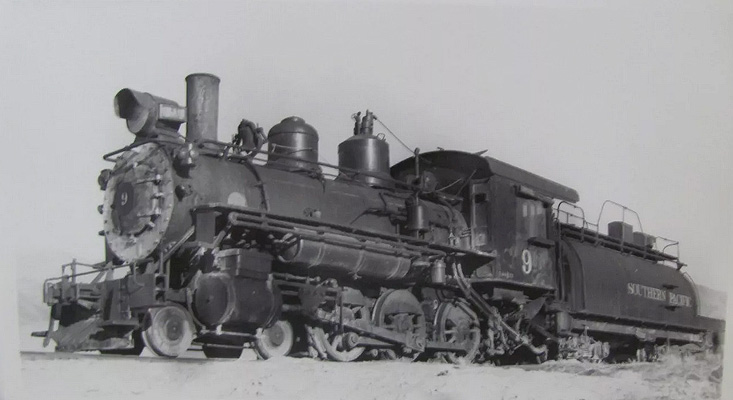 SPNG #9 in Keeler, CA - 1952
SPNG #9 in Keeler, CA - 1952
(Photo courtesy of eBay) |
 11/22
 Keeler rail yard
Keeler rail yard
|
 09/22
 Slim Princess Engine #9 leaving NSP south of Keeler - October 11, 1946
Slim Princess Engine #9 leaving NSP south of Keeler - October 11, 1946
(Photo courtesy of Dennis Burke) |
 05/23
 While the change over from steam motive power to that of diesels took place all across the Country in the 1950's, in no place was it more surprising to see that transition than in the Owens Valley of California on the Southern Pacific narrow gauge Keeler Branch. This was the last place that one would have expected the parent railroad to make the investment modern diesel power.
While the change over from steam motive power to that of diesels took place all across the Country in the 1950's, in no place was it more surprising to see that transition than in the Owens Valley of California on the Southern Pacific narrow gauge Keeler Branch. This was the last place that one would have expected the parent railroad to make the investment modern diesel power.
By the 1950's the Keeler Branch was already anachronism. She had outlasted even her original Carson & Colorado Ry founders who soon after it's completion dubbed the line as having been built as, "either 300 miles too far, or 300 years too soon". To say that the line struggled financially for it's last several decades is to be kind.
With this in mind, in 1954 the railfan world must have been stunned to learn that Southern Pacific thought enough about the future of the Keeler Branch to order from GE a new 50-ton diesel electric locomotive for the line. At the locomotive's dedication in October 1954 she was dubbed the "Little Giant" and soon put to work as the primary power for the line.
Fortunately for railfans, #1 would need regular servicing in the SP shops in Bakersfield, California, thus giving the chance for stand-by power 4-6-0 #9 to venture back out on the line for the delight of the photographers.
All good things come to an end, and in April 1960 the Keeler Branch ran it's last train with #9 and a string of cars to be placed on display at the depot and yards in Laws at the north end of the line where they still are today. #1 found her way to Mexico and may still be there today.
If the "Little Giant" gave the line and #9 a few more years of life, then she definitely was a success.
(Photo and text courtesy of Martin Hansen) |



|



























































































































































































































